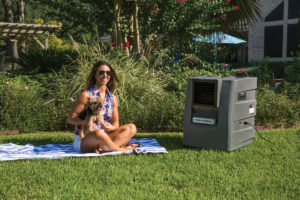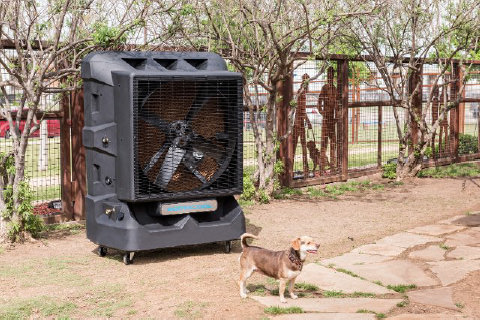
National Pet Week – Protecting Animals from the Heat
Did you know that May 8-12 is National Pet Week as deemed by the American Veterinary Medical Association? As vets will tell you, an important consideration for pet care is ensuring their safety in hot conditions. Mark Jousan, DVM, is a Texas-based licensed veterinarian who treats all types of pets and animals at Shelby Veterinary Associates, PLLC, a full-service animal hospital. He recently shared with us the importance of keeping animals (especially dogs) appropriately cool and comfortable in hot conditions. Mark and his team are dedicated to pet health and well-being and utilize two Portacool evaporative coolers in his kennels for airflow in the open space. He offered these important notations:
- Open air shelters, groomers and others working with animals in big open spaces that are housing animals need adequate to keep conditions pleasant:
- Dogs that are pleasantly cool will behave better when they have a better quality of life; less agitation and stress is better overall
- Increased airflow will help improve air quality because it assists with dissipating the smells from urine; this generally improves the animal’s quality of life where they are being kept
- Once a shelter’s air temperatures reach 80-85°F – it gets really hot for the dogs fast
- Just like for humans – heat stress comes on fast for dogs so extra precaution is key when it is hot
- Evaporative coolers are a great option because they provide cooling outdoors working in the ambient air to provide a noticeable difference in airflow and cooling. This helps reduce heat stress and is very important for:
- older animals/aging animals
- obese animals
- animals with health conditions such as heart disease (in addition to airflow, providing moist air assists with breathing)
- non-active dogs/animals
- If you aren’t sure if it is too hot for your animal, a good rule of thumb/tip is to check TSA and the airlines regarding their maximum heat temp they fly crated dogs within the plane’s underbelly. Their rules are a good gauge for determining heat conditions that can affect animals.
- Make a point to acclimate an indoor dog that will be kept outdoors for extended periods in the heat. Acclimating is an important step.
- For example, a teacher who has had a dog indoors all summer and then returns to work in August and needs to keep the dog on in the backyard or patio thereafter. It would be important to build up by acclimating the dog in stages. This could include increased exposure to the outdoors in increments, allowing the dog to hang-out on the shaded porch or other places like a shade tree ahead of the daily exposure.


